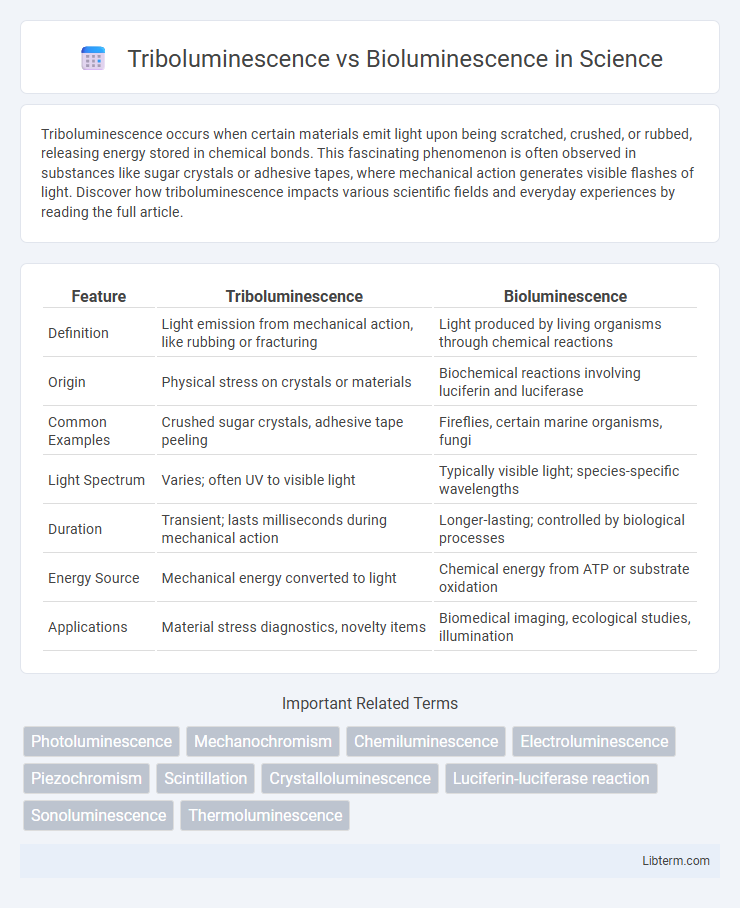Triboluminescence occurs when certain materials emit light upon being scratched, crushed, or rubbed, releasing energy stored in chemical bonds. This fascinating phenomenon is often observed in substances like sugar crystals or adhesive tapes, where mechanical action generates visible flashes of light. Discover how triboluminescence impacts various scientific fields and everyday experiences by reading the full article.
Table of Comparison
| Feature | Triboluminescence | Bioluminescence |
|---|---|---|
| Definition | Light emission from mechanical action, like rubbing or fracturing | Light produced by living organisms through chemical reactions |
| Origin | Physical stress on crystals or materials | Biochemical reactions involving luciferin and luciferase |
| Common Examples | Crushed sugar crystals, adhesive tape peeling | Fireflies, certain marine organisms, fungi |
| Light Spectrum | Varies; often UV to visible light | Typically visible light; species-specific wavelengths |
| Duration | Transient; lasts milliseconds during mechanical action | Longer-lasting; controlled by biological processes |
| Energy Source | Mechanical energy converted to light | Chemical energy from ATP or substrate oxidation |
| Applications | Material stress diagnostics, novelty items | Biomedical imaging, ecological studies, illumination |
Introduction to Luminescence Phenomena
Luminescence phenomena encompass various types of light emission from substances without heat, primarily including triboluminescence and bioluminescence. Triboluminescence occurs when light is generated through mechanical action such as friction, crushing, or rubbing crystalline materials. Bioluminescence is the natural emission of light by living organisms, resulting from enzymatic reactions involving luciferin and luciferase.
What is Triboluminescence?
Triboluminescence is the emission of light generated when certain materials are mechanically stressed, such as being rubbed, scratched, or crushed, causing the breaking of chemical bonds. This phenomenon occurs due to the separation and recombination of electrical charges in crystalline structures, often observed in substances like sugar crystals or adhesive tapes. Unlike bioluminescence, which is a biologically driven light produced by living organisms, triboluminescence arises purely from physical mechanical interactions.
Understanding Bioluminescence
Bioluminescence is the natural emission of light by living organisms such as fireflies, certain fungi, and deep-sea fish, caused by a chemical reaction between luciferin and luciferase enzymes. This biochemical process plays crucial roles in communication, predation, and camouflage within various ecosystems. Unlike triboluminescence, which results from mechanical action on crystals, bioluminescence is a controlled biological mechanism for light production.
Key Differences in Light Emission Mechanisms
Triboluminescence occurs when light is generated through mechanical action such as friction, pressure, or rubbing, causing electron excitation and photon release in crystalline materials. Bioluminescence results from enzymatic reactions within living organisms, where luciferase catalyzes the oxidation of luciferin molecules, emitting light in a controlled biochemical process. Key differences between triboluminescence and bioluminescence lie in their sources--physical mechanical energy versus biological chemical energy--and their occurrence in non-living crystals compared to living organisms.
Common Examples of Triboluminescent Materials
Triboluminescence occurs when certain materials emit light upon mechanical stimulation such as rubbing, crushing, or fracturing, with common examples including sugar crystals, quartz, and adhesive tapes. These materials reveal light emission due to the breaking of chemical bonds and the separation and recombination of electrical charges during mechanical stress. In contrast, bioluminescence is a biological process involving enzyme-driven chemical reactions in organisms like fireflies and certain marine species, producing light without mechanical input.
Natural Occurrences of Bioluminescence
Bioluminescence naturally occurs in various marine organisms, such as deep-sea fish, jellyfish, and plankton, where it serves functions like predation, camouflage, and communication. Certain terrestrial organisms, including fireflies and some fungi species, also exhibit bioluminescence for mating signals or deterrence of predators. Unlike triboluminescence, which involves light emission through mechanical action, bioluminescence results from enzymatic reactions within living organisms.
Scientific Applications of Triboluminescence
Triboluminescence, the emission of light when certain crystals are fractured, plays a significant role in stress analysis and material testing by providing a visual indicator of crack formation and propagation. In contrast to bioluminescence, which is widely used in biological imaging and environmental monitoring, triboluminescence offers unique advantages in mechanical engineering and fracture dynamics research. Its ability to reveal stress distribution in transparent and opaque materials makes it a valuable tool for improving safety and durability in aerospace, automotive, and structural materials applications.
Ecological Roles of Bioluminescence
Bioluminescence plays crucial ecological roles in marine and terrestrial ecosystems by facilitating communication, predator avoidance, and prey attraction through light production via biochemical reactions. Many deep-sea organisms utilize bioluminescence for camouflage and mating signals, enhancing survival and reproductive success in low-light environments. In contrast, triboluminescence, which occurs from mechanical energy release during material fracture, lacks significant ecological functions and is primarily observed in non-living crystalline substances.
Technological Innovations Inspired by Both
Triboluminescence, generated by mechanical stress on crystals, has inspired innovations in stress sensors and damage detection systems, while bioluminescence, produced by living organisms, drives advancements in medical imaging and sustainable lighting technologies. Researchers are developing triboluminescent materials for self-powered sensors in structural health monitoring, enhancing safety in aerospace and civil engineering. Bioluminescent mechanisms are harnessed in bioassays and environmental monitoring, enabling highly sensitive detection of pollutants and pathogens with minimal energy consumption.
Future Research and Potential Developments
Future research in triboluminescence is exploring novel crystalline materials with enhanced light emission efficiency for advanced sensor technologies, while bioluminescence studies aim to engineer genetically modified organisms to produce customizable light wavelengths for medical imaging and environmental monitoring. Advances in nanotechnology are expected to improve the stability and intensity of triboluminescent signals, facilitating real-time structural health monitoring. The integration of bioluminescent systems with synthetic biology holds potential for innovative applications in sustainable lighting and bio-computing devices.
Triboluminescence Infographic

 libterm.com
libterm.com